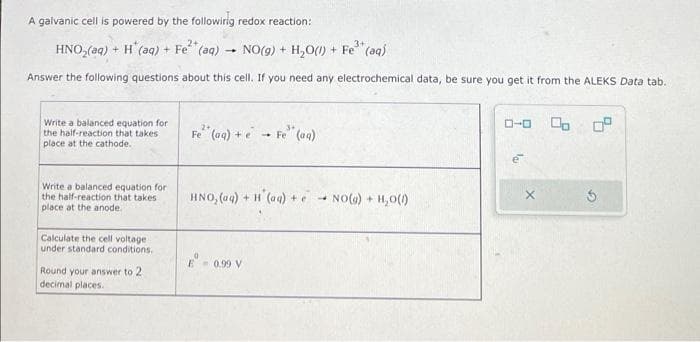A galvanic cell is powered by the following redox reaction: HNO₂(aq) + H(aq) + Fe²* (aq) 3+ NO(g) + H₂O(l) + Fe³+ (aq) Answer the following questions about this cell. If you need any electrochemical data, be sure you get it from the ALEKS Data tab. Write a balanced equation for the half-reaction that takes place at the cathode. Write a balanced equation for the half-reaction that takes i place at anode. Calculate the cell voltage under standard conditions. Round your answer to 2 decimal places. 1 Fe (aq) + e → Fe (aq) HNO, (aq) + H(aq) + E- 0.99 V 7 NO(g) + H₂O()
A galvanic cell is powered by the following redox reaction: HNO₂(aq) + H(aq) + Fe²* (aq) 3+ NO(g) + H₂O(l) + Fe³+ (aq) Answer the following questions about this cell. If you need any electrochemical data, be sure you get it from the ALEKS Data tab. Write a balanced equation for the half-reaction that takes place at the cathode. Write a balanced equation for the half-reaction that takes i place at anode. Calculate the cell voltage under standard conditions. Round your answer to 2 decimal places. 1 Fe (aq) + e → Fe (aq) HNO, (aq) + H(aq) + E- 0.99 V 7 NO(g) + H₂O()
Chemistry & Chemical Reactivity
10th Edition
ISBN:9781337399074
Author:John C. Kotz, Paul M. Treichel, John Townsend, David Treichel
Publisher:John C. Kotz, Paul M. Treichel, John Townsend, David Treichel
Chapter19: Principles Of Chemical Reactivity: Electron Transfer Reactions
Section19.9: Corrosion: Redox Reactions In The Environment
Problem 2.5ACP: Assume the following electrochemical cell simulates the galvanic cell formed by copper and zinc in...
Related questions
Question
100%

Transcribed Image Text:A galvanic cell is powered by the following redox reaction:
3+
HNO₂(aq) + H(aq) + Fe (aq)
NO(g) + H₂O(1) + Fe³+ (aq)
Answer the following questions about this cell. If you need any electrochemical data, be sure you get it from the ALEKS Data tab.
Write a balanced equation for
the half-reaction that takes i
place at the cathode.
Write a balanced equation for
the half-reaction that takes
place at the anode.
Calculate the cell voltage
under standard conditions.
Round your answer to 2
decimal places.
1
Fe (aq) + e → Fe (aq)
HNO, (aq) + H (aq) +
E- 0.99 V
NO(g) + H₂O()
la
Expert Solution
This question has been solved!
Explore an expertly crafted, step-by-step solution for a thorough understanding of key concepts.
Step by step
Solved in 2 steps with 2 images

Knowledge Booster
Learn more about
Need a deep-dive on the concept behind this application? Look no further. Learn more about this topic, chemistry and related others by exploring similar questions and additional content below.Recommended textbooks for you

Chemistry & Chemical Reactivity
Chemistry
ISBN:
9781337399074
Author:
John C. Kotz, Paul M. Treichel, John Townsend, David Treichel
Publisher:
Cengage Learning

Principles of Modern Chemistry
Chemistry
ISBN:
9781305079113
Author:
David W. Oxtoby, H. Pat Gillis, Laurie J. Butler
Publisher:
Cengage Learning

General Chemistry - Standalone book (MindTap Cour…
Chemistry
ISBN:
9781305580343
Author:
Steven D. Gammon, Ebbing, Darrell Ebbing, Steven D., Darrell; Gammon, Darrell Ebbing; Steven D. Gammon, Darrell D.; Gammon, Ebbing; Steven D. Gammon; Darrell
Publisher:
Cengage Learning

Chemistry & Chemical Reactivity
Chemistry
ISBN:
9781337399074
Author:
John C. Kotz, Paul M. Treichel, John Townsend, David Treichel
Publisher:
Cengage Learning

Principles of Modern Chemistry
Chemistry
ISBN:
9781305079113
Author:
David W. Oxtoby, H. Pat Gillis, Laurie J. Butler
Publisher:
Cengage Learning

General Chemistry - Standalone book (MindTap Cour…
Chemistry
ISBN:
9781305580343
Author:
Steven D. Gammon, Ebbing, Darrell Ebbing, Steven D., Darrell; Gammon, Darrell Ebbing; Steven D. Gammon, Darrell D.; Gammon, Ebbing; Steven D. Gammon; Darrell
Publisher:
Cengage Learning

Chemistry
Chemistry
ISBN:
9781305957404
Author:
Steven S. Zumdahl, Susan A. Zumdahl, Donald J. DeCoste
Publisher:
Cengage Learning

Chemistry: An Atoms First Approach
Chemistry
ISBN:
9781305079243
Author:
Steven S. Zumdahl, Susan A. Zumdahl
Publisher:
Cengage Learning

Chemistry: Principles and Practice
Chemistry
ISBN:
9780534420123
Author:
Daniel L. Reger, Scott R. Goode, David W. Ball, Edward Mercer
Publisher:
Cengage Learning